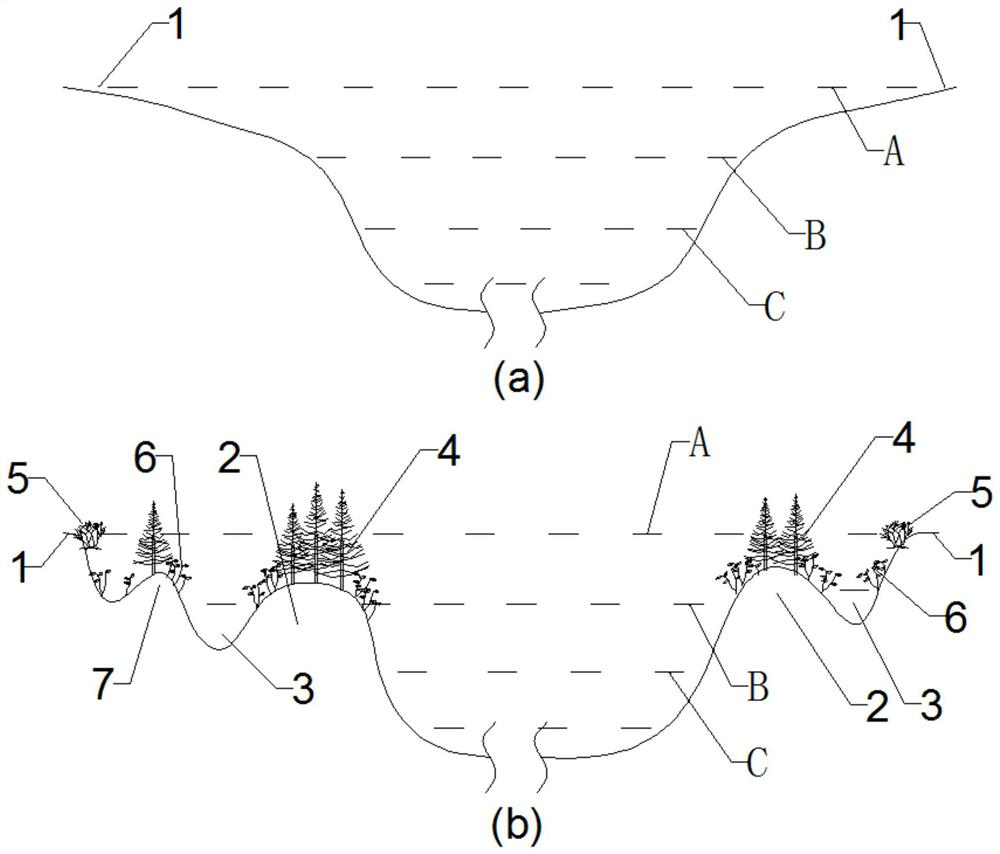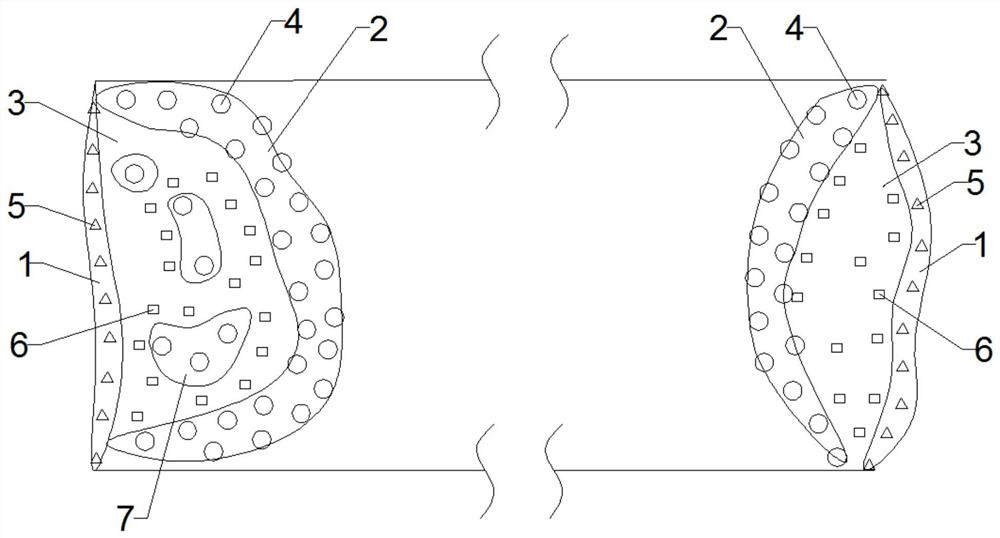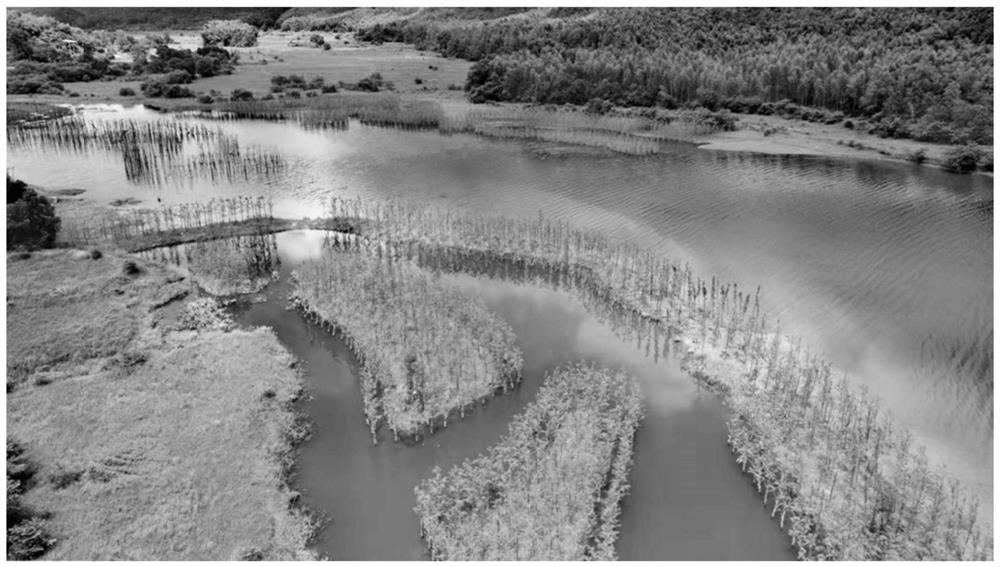Reservoir tail hydro-fluctuation belt wetland restoration method based on forest habitat
A restoration method and technology of water-fluctuating zones, applied in chemical instruments and methods, botanical equipment and methods, river regulation, etc., can solve problems of poor water resistance, disappearance of vegetation in water-fluctuating zones, and plant growth in water-fluctuating zones To achieve the effect of improving spatial heterogeneity, increasing the plantable area, and maintaining biodiversity
- Summary
- Abstract
- Description
- Claims
- Application Information
AI Technical Summary
Problems solved by technology
Method used
Image
Examples
Embodiment 1
[0042] For the hydrofluctuation zone at the tail of the reservoir with a slope of ≤30° on both sides, a wetland restoration method for the hydrofluctuation zone at the tail of the reservoir based on the forest habitat includes the following steps:
[0043] S1, select the pond fir which is resistant to flooding as a large tree 4, and require the height after planting to be 40-60 cm above the highest water level after the highest water level is submerged, and the diameter is 5 cm-10 cm;
[0044] S2. Planting: choose glandular willow and japonica as small trees 5, and plant them in a staggered ratio of 1:1 in a place near the pond 3 along the river bank, with a planting distance of 4m×4m; directly plant Pond fir under the small trees 5 And the pond firs at both ends move closer to the riparian zone 1, and the planting spacing is 5m×5m.
Embodiment 2
[0046] A wetland restoration method based on the Linze habitat, comprising the following steps:
[0047] S1. Soil preparation: carry out topographic reconstruction and plasticity on the side of the water-fluctuation zone at the end of the reservoir with a slope of 30°≤slope≤60°, and obtain several ponds 3 and several soil mounds near the bank zone 1 at the edge of the water-fluctuation zone by digging ditches and piling up soil 2. The soil mound 2 and the pond 3 along the riparian zone 1 are arranged to form a saucer-shaped lake, and a number of small soil mounds 7 are arranged inside the saucer-shaped lake, and the silt excavated from the water bottom is piled on the soil mound 2 and the small soil Heap 7 is used for fertilization; the other side of the sink-fluctuation zone with a slope ≤ 30° does not prepare the soil;
[0048] S2, select Zhongshan fir and Chinese pine which are resistant to flooding as large arbors 4, and require the height after planting to be 50-80 cm abo...
Embodiment 3
[0051] For the water-fluctuating zone at the tail of the reservoir with slopes of 30° to 60° on both sides, a wetland restoration method based on the Linze habitat includes the following steps:
[0052] S1. Land preparation: carry out topographic reconstruction and plasticity on the water-fluctuating zone at the end of the reservoir, and obtain several ponds 3 and some soil mounds 2 near the edge of the water-fluctuating zone along the bank zone 1 by digging ditches and piling up soil. The riparian zone 1 is arranged around the pond 3 to form a dish-shaped lake shape, and some small-scale soil mounds 7 are arranged in the inside of the dish-shaped lake on the left side of the direction shown in the figure, and the right side is not provided. Heap 7 for fertilizer;
[0053] S2, select the Zhongshan fir that is resistant to flooding as a large tree 4, and require that the height after planting be that the top of the tree can exceed the maximum water level by 20-50 cm after the h...
PUM
| Property | Measurement | Unit |
|---|---|---|
| diameter | aaaaa | aaaaa |
| height | aaaaa | aaaaa |
| diameter | aaaaa | aaaaa |
Abstract
Description
Claims
Application Information
 Login to View More
Login to View More - R&D
- Intellectual Property
- Life Sciences
- Materials
- Tech Scout
- Unparalleled Data Quality
- Higher Quality Content
- 60% Fewer Hallucinations
Browse by: Latest US Patents, China's latest patents, Technical Efficacy Thesaurus, Application Domain, Technology Topic, Popular Technical Reports.
© 2025 PatSnap. All rights reserved.Legal|Privacy policy|Modern Slavery Act Transparency Statement|Sitemap|About US| Contact US: help@patsnap.com



